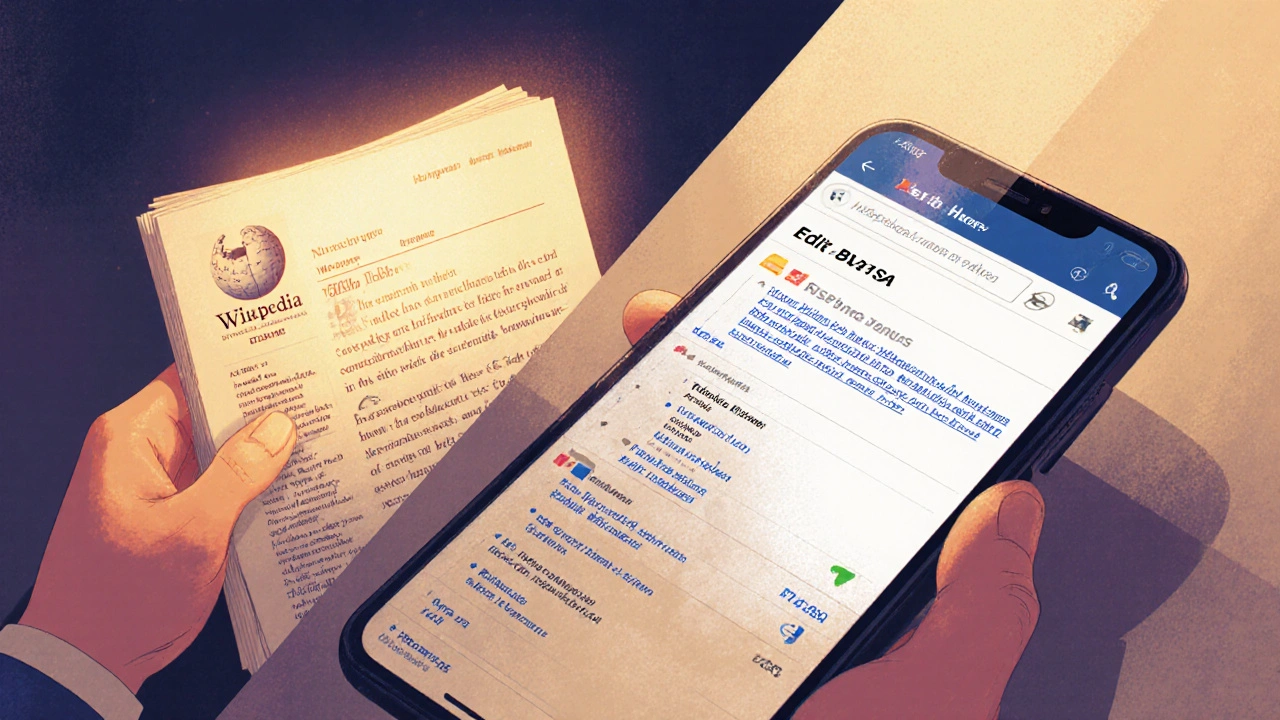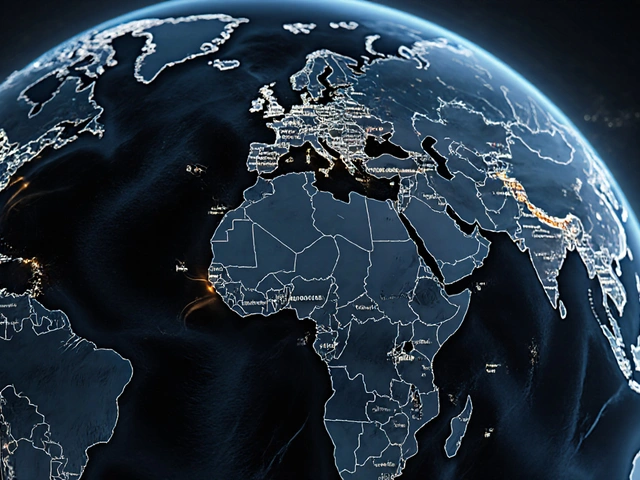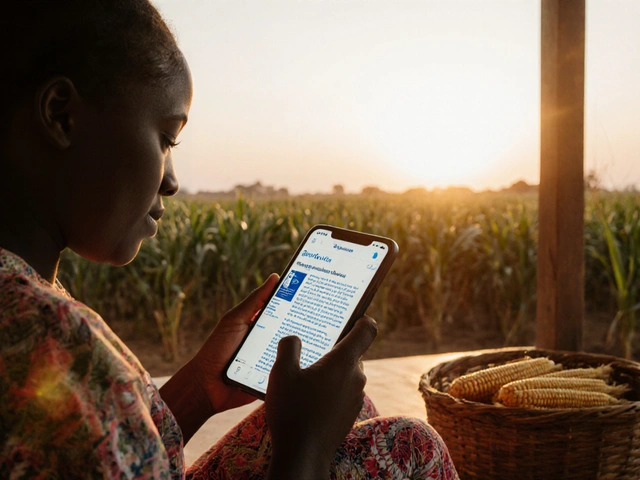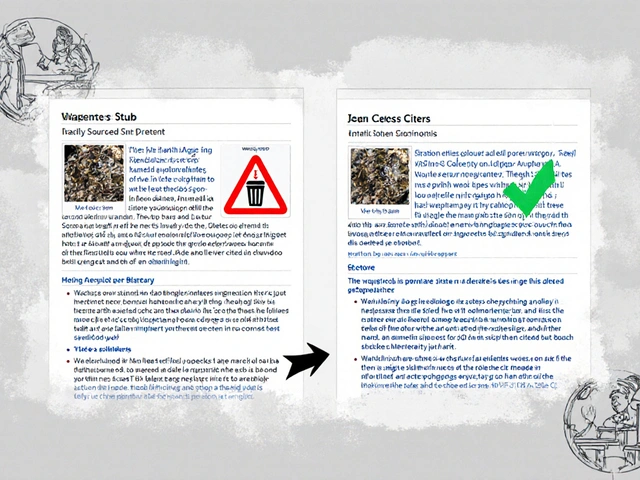
Wikipedia doesn’t own the words you read on it. That’s not a bug-it’s the whole point. Every article, image, and edit you see is licensed under CC BY-SA, which stands for Creative Commons Attribution-ShareAlike. This license lets anyone copy, adapt, and even sell Wikipedia’s content, as long as they give credit and pass along the same freedoms to others. It’s why you can find Wikipedia articles in textbooks, school websites, and even mobile apps without legal trouble. But understanding how this license works-especially across versions and with other licenses-isn’t simple. If you’ve ever wondered why some content can’t be reused even if it’s from Wikipedia, or why a new version of the license changed everything, here’s how it actually works.
What CC BY-SA Really Means
CC BY-SA is a two-part license. The first part, Attribution, means you must credit the original creators. On Wikipedia, that usually means linking back to the article’s history page, where every edit is tracked. The second part, ShareAlike, means if you remix, transform, or build on the material, you must distribute your version under the same license. You can’t take a Wikipedia article, add your own spin, and then lock it behind a paywall or copyright it under a stricter license.
This isn’t just legal jargon. It’s how Wikipedia stays free. If someone took a 10,000-word entry on climate change, rewrote half of it, and sold it as their own ebook without sharing it freely, they’d be breaking the rules. But if they posted it on their blog with a link to the original and marked their version as CC BY-SA too? That’s exactly what the system encourages.
Versioning: Why 1.0, 2.0, and 4.0 Matter
Wikipedia switched from CC BY-SA 1.0 to 2.0 in 2007, then to 3.0 in 2009, and finally to 4.0 in 2013. Each version tightened loopholes and made the license more usable around the world. But here’s the catch: content licensed under 1.0 isn’t automatically compatible with 4.0. That means an article edited in 2006 and never touched since is still under 1.0, while a new edit today is under 4.0.
This creates a patchwork. If you want to reuse content from Wikipedia, you need to know which version you’re pulling from. The version is tied to the edit history. You can’t just grab the current version of an old article and assume it’s 4.0. The license version is locked to the content as it existed at the time of the last major contribution.
Wikipedia solved this with a dual-licensing trick. In 2009, the Wikimedia Foundation re-licensed all content under both CC BY-SA 3.0 and the GNU Free Documentation License (GFDL). That gave users a fallback. But in 2013, when they moved to CC BY-SA 4.0, they didn’t relicense the old content. So today, you have a mix: newer edits are 4.0, older ones are still 3.0 or even 1.0. You need to check the page’s history to know what you’re working with.
License Compatibility: Can You Mix It With Other Content?
Here’s where things get messy. Not all free licenses play nice together. CC BY-SA 4.0 is designed to be compatible with other licenses that have similar requirements-like the GFDL 1.3. But it’s not compatible with licenses that are more restrictive. For example, you can’t combine CC BY-SA content with content under CC BY-NC (NonCommercial), because NC bans commercial use, while BY-SA requires free sharing. Mixing them breaks the license.
Wikipedia’s strict rule: if you’re adding outside content to a Wikipedia article, it must be under a compatible license. That’s why you rarely see photos from Flickr or stock image sites in Wikipedia articles. Most are under All Rights Reserved or CC BY-NC. Even if the photo is free, if it doesn’t allow commercial use or doesn’t require ShareAlike, it’s blocked.
There are exceptions. Some institutions, like museums or universities, donate content under CC BY-SA. The Smithsonian, for instance, released over a million images under this license. Those can be used freely. But if you’re uploading a photo you took yourself, you must explicitly choose CC BY-SA or a compatible license. Otherwise, it gets deleted.

Reusing Wikipedia Content: What’s Allowed and What’s Not
Let’s say you’re a teacher building a lesson plan. You can copy a Wikipedia article, paste it into a PDF, print it for your class, and hand it out. That’s fine. You just need to credit Wikipedia and link to the original article. You don’t need permission. You don’t even need to ask.
But if you’re building a commercial app that pulls Wikipedia data, you have to follow the rules too. Apps like Wikiwand, Wikipedia Zero, or even AI chatbots that use Wikipedia as a source must display attribution and ensure their output is also CC BY-SA. That’s why some AI companies avoid using Wikipedia directly-they can’t control how their models recombine and redistribute the content under the same license.
There’s one big trap: if you edit a Wikipedia article and then copy your own edits elsewhere, you still have to license them under CC BY-SA. You don’t own the copyright to your edits just because you wrote them. The community does. That’s why Wikipedia’s terms of use say you’re granting them a perpetual, irrevocable license to use your edits under CC BY-SA.
Why This System Works-And Why It’s Rare
Most websites don’t do this. Google, YouTube, and even Reddit lock their content behind terms that say, "You can’t reuse this without our permission." Wikipedia is one of the few massive platforms that gives its content away for free, with no strings attached-except that you keep it free.
This system works because of scale. With over 60 million articles in 300+ languages, the cost of policing reuse is too high. Instead, Wikipedia relies on community norms. If someone violates the license, the community reports it. Platforms like GitHub, OpenStreetMap, and Wikidata use the same model. It’s not perfect, but it’s the only way to build a global knowledge base that stays open.
The real power of CC BY-SA isn’t in the license itself-it’s in the culture. People contribute knowing their work won’t be locked up. They trust that if someone uses their words, they’ll pass the same freedom on. That’s why Wikipedia keeps growing. Not because it’s paid for. But because it’s shared.

How to Check a Wikipedia Article’s License Version
If you plan to reuse content, always check the license version. Here’s how:
- Go to the Wikipedia article.
- Scroll to the bottom and click "View history".
- Look for the earliest major edit that added substantial content.
- Click on the edit summary or the timestamp to see the license note.
- If it says "CC BY-SA 4.0", you’re safe to reuse under that version. If it says "GFDL 1.3" or "CC BY-SA 3.0", you must follow those terms.
For bulk reuse-like downloading all articles for a research project-use the Wikimedia dumps. These are official, licensed exports of Wikipedia content, clearly marked with version info. They’re the safest way to reuse large amounts of data without accidentally breaking a license.
What Happens If You Break the License?
Most violations go unnoticed. But if someone takes a Wikipedia article, removes all attribution, sells it as a book, and doesn’t share their version under CC BY-SA, the Wikimedia Foundation can act. They’ve done it before. In 2017, a publisher in Germany was ordered to stop selling a book that copied 50 Wikipedia articles without credit or ShareAlike compliance. The court sided with Wikipedia.
But enforcement is rare. The real deterrent is community backlash. If you’re caught violating the license, you’ll likely get flagged by editors, called out on forums, and lose credibility in open knowledge circles. In the world of free culture, reputation matters more than lawsuits.
Can I use Wikipedia content in my YouTube video?
Yes, as long as you give proper credit and license your video under CC BY-SA or a compatible license. You must mention Wikipedia as the source and link to the original article. If your video is monetized, that’s still allowed-CC BY-SA permits commercial use. But if you lock your video behind a paywall or claim exclusive copyright over the reused content, you’re violating the license.
Is CC BY-SA the same as public domain?
No. Public domain means no copyright restrictions at all. CC BY-SA still requires attribution and ShareAlike. You can’t take CC BY-SA content, strip the credit, and claim it as your own. Public domain works can be used without any conditions. Wikipedia content is never public domain-it’s always under license.
Can I combine Wikipedia text with content from another CC BY-SA site?
Yes, as long as both are under compatible versions. CC BY-SA 4.0 is designed to be compatible with other 4.0 licenses. If you’re mixing content from Wikipedia (4.0) and OpenStreetMap (also 4.0), you can merge them into one project. Just make sure the final product is licensed as CC BY-SA 4.0 and gives credit to both sources.
Why doesn’t Wikipedia use a simpler license like CC0?
CC0 removes all restrictions, including attribution. Wikipedia’s community believes credit matters. Attribution ensures contributors are recognized, and ShareAlike ensures the knowledge stays free. If Wikipedia used CC0, someone could take a well-researched article, remove all credits, and sell it as a proprietary product. The ShareAlike clause prevents that.
What if I want to use Wikipedia content in a paid course?
You can. Charging for a course is allowed under CC BY-SA. But you must still credit Wikipedia and license your course materials under the same terms. That means if a student downloads your slides or handouts, they can legally reuse and share them too. You can’t restrict their ability to redistribute your content. If you don’t want that, don’t use Wikipedia content.
Next Steps for Reusers
If you’re planning to reuse Wikipedia content, start here:
- Always check the edit history for license version.
- Use Wikimedia dumps for large-scale reuse-they’re pre-licensed and documented.
- Never mix CC BY-SA with NC or ND licensed content.
- When in doubt, license your derivative work as CC BY-SA 4.0.
- When in doubt, credit Wikipedia clearly and link to the original article.
This isn’t about legal fear. It’s about respecting a system that lets anyone, anywhere, access and build on human knowledge. The license isn’t a wall-it’s a bridge. And it only works if everyone walks across it the same way.






